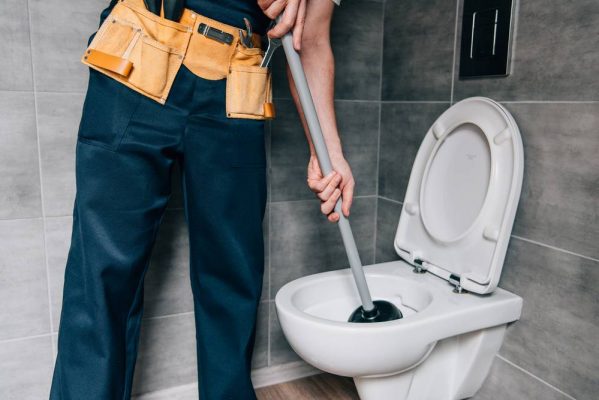How do you really feel about How to Unclog Your Sink with a Plunger?

Introduction
Correct maintenance of family drains pipes is vital for protecting against clogs and guaranteeing smooth water circulation. One of the secret devices in every homeowner's toolkit is the plunger, together with different drainpipe cleansers made to tackle stubborn clogs efficiently. This post checks out exactly how to utilize bettors and drain cleaners efficiently to keep your drains flowing openly.
Area 1: Recognizing Bettors
Sorts of Plungers
There are numerous types of plungers offered, each developed for various types of drains and clogs. One of the most typical kinds include mug bettors, flange plungers, and accordion bettors.
How Plungers Job
Plungers work on the concept of creating stress and suction to dislodge obstructions. When appropriately applied over a drainpipe, they create a vacuum cleaner that can pull out debris or separate blockages.
Selecting the Right Bettor
Selecting the ideal bettor depends upon the kind of drainpipe and the nature of the clog. Cup bettors are ideal for sinks and bathtubs, while flange bettors are much better suited for toilets because of their style.
Usual Blunders with Bettors
Avoiding these mistakes guarantees efficient plunging: incorrect seal around the drainpipe, inadequate force, and not clearing surrounding debris.
Section 2: Using Plungers Effectively
Prep work
Prior to diving, make sure the plunger covers the drain entirely and develops a tight seal. Clear any noticeable particles around the drain opening.
Strategy
Beginning with mild plunging movements to develop suction. Increase pressure gradually, using a steady rhythm. Repeat as required until the drainpipe gets rid of.
Fixing Tips
If diving does not work, attempt adjusting the seal, applying oil jelly for a far better seal, or utilizing a different type of plunger.
Section 3: Understanding Drain Cleaners
Kinds Of Drainpipe Cleaning Company
Drain cleansers can be chemical or enzymatic. Chemical cleansers make use of strong chemicals to dissolve blockages, while chemical cleansers make use of all-natural enzymes to break down raw material.
How Drain Cleaners Work
Chemical cleaners react with blockages to dissolve them, while enzymatic cleaners break down organic materials like hair and grease without harming pipelines.
Safety and security Factors to consider
Constantly use gloves and eye protection when using chemical drain cleansers. Make certain adequate ventilation and comply with maker guidelines thoroughly.
Eco-Friendly Alternatives
Take into consideration utilizing vinegar and cooking soda or enzyme-based cleansers for environment-friendly options that are much safer for pipelines and the environment.
Area 4: Making Use Of Drainpipe Cleaners Efficiently
Application Methods
Put chemical cleansers directly into the drainpipe opening. Permit them to work for the suggested time prior to flushing with warm water. Chemical cleansers must rest overnight.
Preventative measures
Prevent blending various types of cleaners, as this can create toxic fumes. Never use chemical cleaners combined with a bettor, as spilling can take place.
Dealing With Stubborn Blockages
For consistent clogs, think about using a plumbing snake or calling a specialist plumber to prevent damages to pipelines.
Final thought
In conclusion, understanding just how to make use of plungers and drain cleansers successfully is vital for maintaining healthy and balanced pipes systems. By choosing the right devices and techniques, homeowners can take on small obstructions and prevent major pipes concerns down the line.
HOW TO USE A PLUNGER TO UNCLOG A TOILET, SINK OR TUB
You have a bad day at work. You get stuck in traffic for hours. You have a pounding headache. And there’s nothing to eat for dinner but leftovers. How can a day this bad get worse? Easy. You flush the toilet or pull the plug on a sink or tub…and the water goes nowhere.
General Plunger Tips:
Make Sure You Use the Proper Plunger for the Job. All plungers are not created equal. There are basically two types — the cup plunger and the flange plunger. The classic cup type — probably the most familiar — is best for sinks, bathtubs and showers. The flange type has an extended rubber lip that provides a better seal for toilets. Keep The Plunger in Good Repair. Any tears of the cup or bell (the rubber part of the plunger) will result in a poor vacuum seal and loss of pressure. Plungers should be kept clean and dry when not in use to prevent cracking or ripping. Never Use a Plunger in Tandem with Drain Cleaning Chemicals. The plunging action will inevitably splatter dangerous chemicals onto your skin or clothing. Chemicals should only be used if a plunger fails to do the job. Remove Excess Water. Too much water in the tub, sink or toilet will make a mess when you start plunging. Use a bucket or siphon to remove water to the half-way point. But don’t entirely remove the water; if there’s no water, the cup won’t be able to form a vacuum seal and generate any pressure. There should always be enough water to submerge the cup. If there’s not enough water, fill a bucket from another source and add. Let Air Out of the Plunger Cup. A common mistake is to leave too much air in the plunger cup. Air, unlike water is compressible. If the cup is filled with air, it will compress every time you press down and act like a shock absorber. As a result, the clog won’t receive as much force. If the cup is filled with water, the force will be much more intense. Make sure you “burp” out the air from the cup and fill with as much water as you can before plunging. Get a Real Tight Seal. An easy way to improve the seal around the plunger is to add some petroleum jelly to the rim of the bell or cup. This will increase the suction. It will also prevent drying and cracking. Block All Other Outlets. If there is another sink or water fixture nearby, you’ll get better results if you block these drains before you start plunging. Get a wet cloth and stuff into these drains. Plunge with a Vertical Up-and-Down Action. Keeping the plunger handle straight and vertical, perpendicular with the base of the toilet, tub or sink is the best way to use a plunger. If you tilt at an angle, you won’t get proper force and the plunger seal can come loose. How To Plunge a Clogged Sink, Tub or Shower:
Use a STANDARD Cup Plunger. Securely Cover and Seal the Overflow Drain with a Wet Rag or Cloth. Submerge the Plunger Cup. Place the plunger over the drain and completely cover the drain opening. Push Down With Quick, Forceful Thrusts. This will concentrate pressure down the drain toward the obstruction. Repeat for 15-20 seconds. How To Plunge a Clogged Toilet:
Use the FLANGE type of plunger. If the bowl is full, put on some gloves and bail out until it is only half-full. If the bowl is empty, add water until it is half-full. Drape a towel over and around the toilet to catch any back-splash. Place the plunger in the bowl and completely cover the drain opening. Push Down With Quick, Forceful Thrusts. This will concentrate pressure down the drain toward the obstruction. Repeat for 15-20 seconds. What if Plunging Fails to Unclog the Clog?
If plunging doesn’t remove the obstruction, you need to pursue more aggressive measures. While there are commercially available chemical drain cleaners and snake devices which can be quite effective at loosening the most stubborn of clogs, homeowners use these techniques at their own risk. Chemicals can burn and damage skin, clothing, pipes and surfaces. Snakes and other mechanical devices can actually compress and enlodge the obstruction more if used improperly.
Your best bet for plunger-resistant clogs is to call an experienced plumbing and drain cleaning professional who can quickly and safely remove the obstruction and get you back in the flow. Our team of emergency plumbers in Elkton, MD and other areas offer dependable drain cleaning services for homes. Our team has the tools necessary to unclog your sink, tub, or toilet. Give our team a call at 1-410-559-9527 to receive help with a clogged drain in your house.
https://www.horizonservices.com/about-us/blog/how-to-use-a-plunger-to-unclog-a-toilet-sink-or-tub/

As an avid person who reads about Here's How to Correctly Use a Toilet Plunger, I figured sharing that chunk was really helpful. In case you appreciated our blog posting kindly don't forget to share it. Many thanks for being here. Don't forget to come by our website back soon.
Call Today
 Neve Campbell Then & Now!
Neve Campbell Then & Now! Tia Carrere Then & Now!
Tia Carrere Then & Now! Ross Bagley Then & Now!
Ross Bagley Then & Now! Yasmine Bleeth Then & Now!
Yasmine Bleeth Then & Now! Destiny’s Child Then & Now!
Destiny’s Child Then & Now!